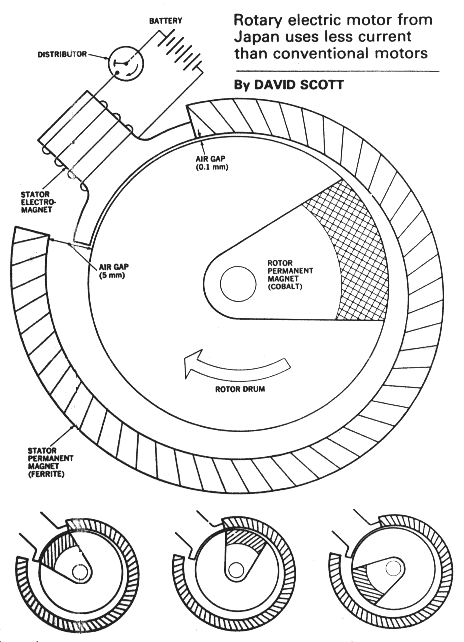
How the magnetic rotary engine works. Rotary electric motor has a small cobalt magnet mounted on the edge ot its drumlike rotor. The magnet spans a narrow 60 degree sector of the rotor?s circumference. The drum spins within a stator ring composed mainly of a permanent ferrite magnet. But the stator has a 60-degree gap spanned by an electromagnet. A distributor geared to the rotor?s center shaft times the flow of current to the electromagnet, energizing it briefly, just as the cobalt magnet swings past ths coils. The electromagnet exerts a repulsive force, kicking tho rotor on its way. The magnet is switched off, and the rotor's speed is maintained by magnetic repulsion between the cobalt magnet and the stator walls. The cleverly designed stator ring actually adds impetus to the rotor's swing. The ferrite ring is not a circle but is a section of a spiral, so its radius gradually expands in the direction of the drum's spin. Thus the stator?s eccentric outer curve encloses a wedge-shaped space between it and the spinning rotor. (This area is similar to the Wankel's elongated combustion chambers. ) The dimensions of the tapered air gap increase gradually, starting at a tight 0.1 mm and slowly expanding to 5.0 mm. The moving cobalt segment always has more space between its leading edge and the stator than there is at its trailing edge. Since the repulsive force between magnets is strongest when they are closest together, the cobalt magnet gets a constant boost from the rear. The magnet is speeded on its way by this superior thrust along its trailing edge. The rotor thus travels a full 300 degrees of its path without consuming energy from the battery. At the end of this freeloading spin, the electromagnet is again swltched on. Just as the cobalt magnet swings by, it gets another powered thrust to begin the next rotary cycle (cycle is illustrated at lower left). The impulse is precisely timed to start after the cobalt magnet reaches top dead center, so it gets boosted off in the right direction. Two or more of these magnetic rotary modules can be combined to make an energy-efficient automotive power plant.
Experimental 45 hp rotary engine uses two separate rotor drums (A), each with three cobalt magnets (B-two shown) spaced 60 degrees apart. The cobalt segments are so angled on the common shaft that there's equal radial spacing around the circle. Each rotor drum spins past its own stator electromagnet (C) that is "fired" by the gear-driven distributor (D). The multipoint distributor gives six power impulses per revolution to kick each of the three cobalt segments along They are propelled the rest of the way by the magnetic forces generated between them and the eccentrically shaped stator rings (E) that cause an ever-widening air gap to face the magnets. The small electric motor (F) crank-starts the rotors. When they are rewed up to 200 rpm, the distributor cuts in the stator coils, and rotor speed increases, going up to 5400 rpm. Speed is controlled by pulsing the DC current to the electromagnets as with conventional battery-powered traction motors.
In this time of uncertain gasoline supplies, electric cars look increasingly attractive. So what's keeping them off our roads? Inefficient batteries are the main problem. Battalions of researchers are working to develop better batteries [PS, Feb.] and thus improve the electrics' speed and cruising range.
 But Kure Tekko, a Japanese engineering firm, has attacked the problem from the other end by developing an engine that reduces the power requirements of electric vehicles. The new engine both weights less and draws less current than conventional electric motors, so fewer batteries are needed to power the car.
But Kure Tekko, a Japanese engineering firm, has attacked the problem from the other end by developing an engine that reduces the power requirements of electric vehicles. The new engine both weights less and draws less current than conventional electric motors, so fewer batteries are needed to power the car.
Jettisoning batteries, in turn, trims an electric's weight, improving its speed and range.The Japanese nicknamed the new design the "magnetic Wankel" because the engine's working principles resemble those of a Wankel-type rotary. In fact, the new engine has some things in common with a conventional auto engine.
Unlike most electric motors, the rotary electric needs crank starting and has a distributor. Like the Wankel, the new design is also lighter and smaller than a gas engine of the same power. And the electric rotary is a pygmy when compared to other electric engines. The prototype 45 hp unit weights only 155 pounds against 440 pounds for a comparable electric motor.
The rotary engine is compact enough to fit inside a two-foot cube, says Kure Tekko. The forces of magnetic repulsion are the key to the new engine's light weight and lowered power demands. Since the engine gets most of its power from the interaction between permanent magnets relatively small amounts of copper and iron are needed for the electromagnets used. This cuts weight and costs.
The permanent magnets are either cobalt or the plastic-bonded ferrite type - both lightweight. The ferrite magnets can also be made fairly cheaply by injection molding. Finally, most of the engine castings, including the rotor, are made of light alloy. The prototype engine shown above is still in an early development stage and no performance details have been revealed. But the rotary electric may become more than just an engineer's plaything. Kure Tekko is a sizeable firm that supplies auto parts to Toyo Kogyo, the Mazda maker. Since Mazda is the world leader in Wankel engines, Toyo Kogyo could have more than a passing interest in the Wankel's electric counterpart.
Дата публикации: Прочитано: 22700 раз